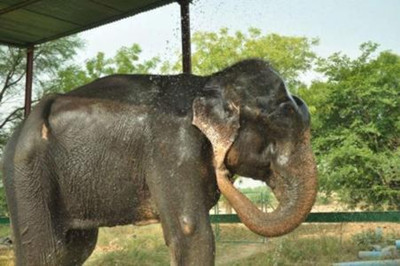In the time it takes you to listen to this story, an elephant could empty its bladder about three times.
这个故事中你需要留意下时间,一头大象需要3次才能将膀胱完全腾空。
And, despite being much smaller, so could an adult cat.
然而,虽然相比之下成年猫的膀胱较小,但也是如此。
And a goat. Also a cow.
羊如此。牛也是这样。
Because researchers find that all mammals that weigh more than six-and-a-half pounds or so take about the same time to pee:
因为研究人员们发现所有体重超过6.5磅左右的哺乳类动物小便花费的都是同样长的时间:
21 seconds, plus or minus 13 seconds.
21秒正负不超过13秒误差。

The researchers videoed various mammals urinating at Zoo Atlanta.
研究人员们将亚特兰大动物园各类哺乳动物的排尿过程用视频的方式记录下来。
And they found that, once you get above the squirrel-mouse-shrew level, tinkle-time does not scale with body size.
然后他们发现,一旦达到松鼠-老鼠-地鼠级别以上,排尿时间并不会随着身材的增加而增加。
Good news for elephants, who could otherwise spend all day going number one.
这对大象来讲是个好消息,否则它估计要花整天时间排尿,因此雄霸第一的宝座。
Seems that larger animals have a longer urethra, the conduit that whisks the wee-wee away.
大型动物虽然看起来尿道更长,但导管结构使得排尿过程很快。
That difference in size is big enough that gravity starts to really weigh in.
而体型的区别决定了重力方面的相关作用。
As a result, when Jumbo answers nature's call he has a much faster flow than does Mittens.
结果就是,当大象有了生理上的需求,速度会比小猫咪快很多。
Given the urethra's structure, the researchers say that the mammalian urinary system can be “scaled up by a factor of 3,600 in volume without compromising its function.”
而且通过尿道结构,研究人员们表示,哺乳动物的泌尿系统如果排除了功能差异,随体型递增的相关因子大概是体积的3600倍。
The study is in the Proceedings of the National Academy of Sciences.
该研究已在《国家科学研究进展》杂志上发表。
This hydrodynamic finding could help engineers design systems that rapidly drain reservoirs, regardless of size.
这项流体动力学的发现也许有助于工程师们设计出任何尺寸可快速排水的蓄水池。
It also means if Mittens and Jumbo hit the head together, they can come out at the same time.
这同时意味着如果小猫和大象在方便的时候碰巧同时开始,也能同时结束。


